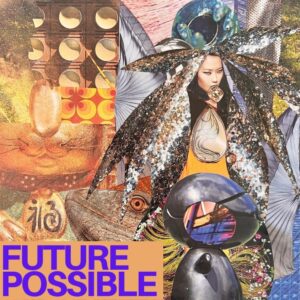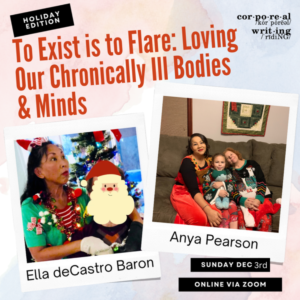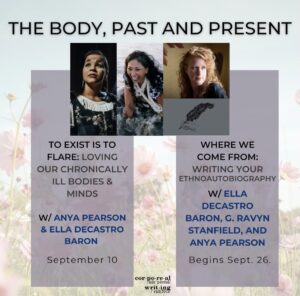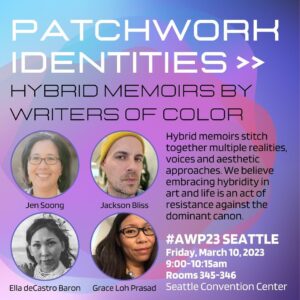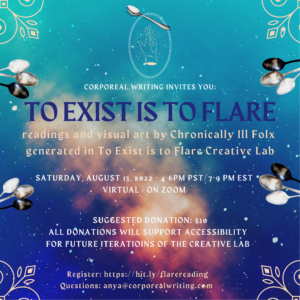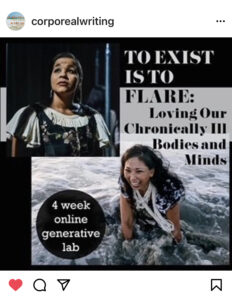Subo and Baon: A Memoir in Bites
Published by City Works Press
In Subo and Baon: A Memoir in Bites, Ella deCastro Baron invites us to a communal meal, a roundtable collection of creative nonfiction. The subo (handfed bites) and baon (food to go) she serves are kitchen counter-stories marinated in Filipino American identity, faith, family, chronic illness, and the complex fullness of being, becoming. Here, ancestors and more-than-human kin conspire, too. This is kapwa, deep interconnection. May those who partake in Ella’s generous offerings savor, metabolize, and be fed by core Filipino values that infuse flavor and sustenance into American culture.
Order a copy for yourself (and a friend!) at Sunbelt Books
Come celebrate this community book (more a “we-moir” than a me-moir) with us at the Filipino American History Month events below. (More gatherings to come!)

Filipino American History Month 2024

*VIRTUAL Talk Story Showcase (REGISTER HERE):
Thursday, Oct. 24, 5:30 pm Pacific/8:30 pm Eastern
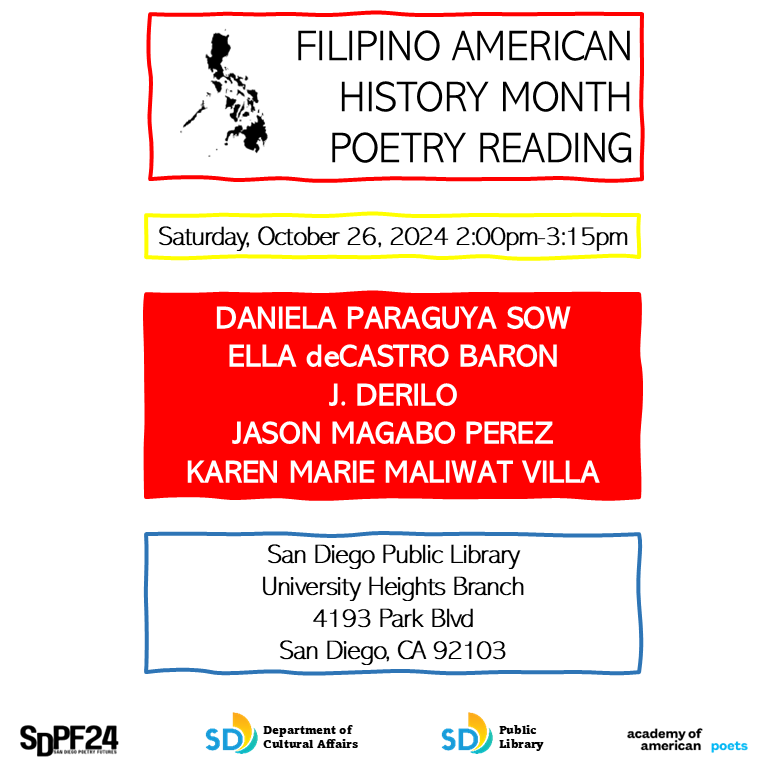
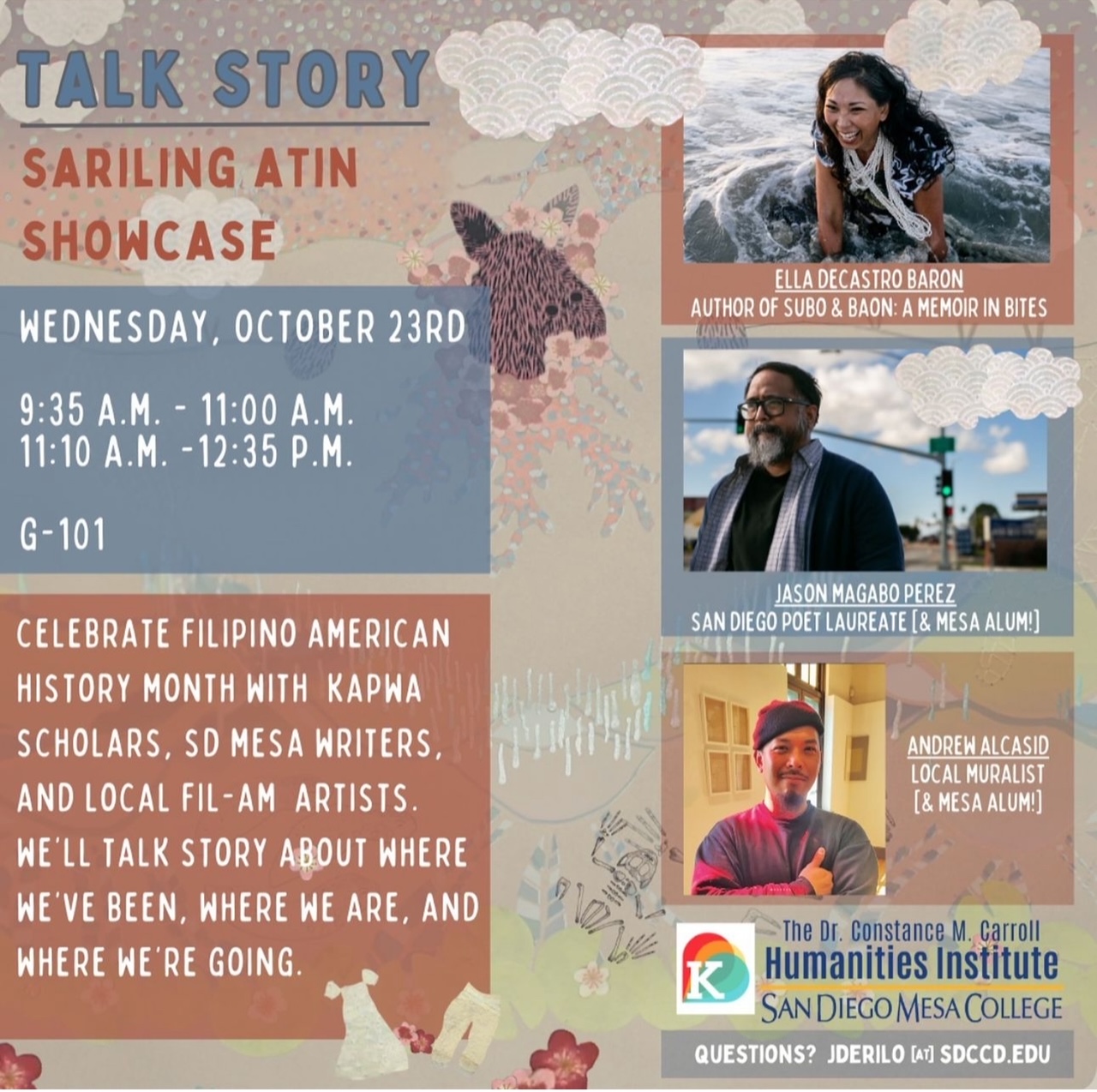
_______________________________________________________
SALO-SALO: UNBOXING
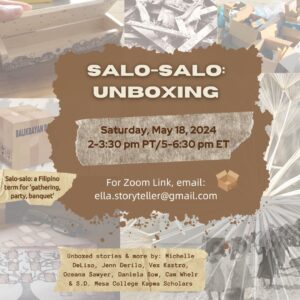
Unboxing: a trend where folks film themselves opening packages to unveil products (tech, gadgets, collectibles, must-haves). These storytellers are unboxing their ancient, transgenerational, quirky, spectral, animist, realest real selves. Checking/unchecking boxes of identity, feeling boxed in (a coffin)…breaking out, balikbayan, bikini area, resisting boxes. Unboxed stories & more by: Michelle DeLiso, Jenn Derilo, Vex Kaztro, Oceana Sawyer, Daniela Sow, Cam Whelr & S.D. Mesa College Kapwa Scholars.
Salo-Salo: “Unboxing”
(virtual storytelling!)
Saturday, May 18, 2024
2-3:30 pm PT/5-6:30 pm ET
For Zoom Link, email: ella.storyteller@gmail.com or Register here
_______________________________________________________
![Flyer for Salo-salo: trans[...]missions & transgressions. Feb. 24, 2024. Over Zoom.](https://elladecastrobaron.com/wp-content/uploads/2024/05/Salo-Salo.-2.25.24.transmissions-and-transgressions-300x300.jpg)
_______________________________________________________
ANMLY#37: BIPOC, “Future Possible”
ANMLY magazine, issue #37 holds space for a BIPOC folio on the theme, “Future Possible” guest edited by Jen Soong. I’m honored to have a piece included: “A Checklist for Dark S[kin] Care” (along with an audio recording and collage art).
Jen and I met at a national writing conference, AWP, in Portland years ago, through a fellow AAPI writer (no doy! I love that we end up finding each other on this lonely planet called Literary Writers). Jen accepted a piece I wrote in response to her call for submissions.
I’ve been learning from Black female writers and activists. They are the prophets because since their ancestors were enslaved, and their bodies became the first American “capital” to build the United States (literally), the African American and Black women storytellers have had to survive and learn to revive themselves & their children, and their dreams over and over.
Somewhere someone in a classroom or workshop or Zoom near-and-far-away or insomniac moment rang a clarity bell over my mind: listen and learn from Black women. Preachers, womanists, teachers, writers, artists, activists (art-ivists), neighbors, friends. I began reading Octavia Butler, returned and swam more deeply with bell hooks and Audre Lorde, was led to adrienne maree brown, Alexis Pauline Gumbs, Tricia Hersey.
“There is no way to keep up with the machine-level pace that capitalism requires. It’s not sustainable, and the first step in moving away from this pace, to craft spaces of rest and care is to grow your imagination. The idea of rest as resistance is a counter-narrative to the dominant story. Protest and resistance don’t look one way.” ~Tricia Hersey
I’m trying to write as a newbie zapped by the spirit of Afro-futurism*, to ground myself in enough freedom, that I’m brave enough to risk DREAMING of the future possible for fellow brown, sick folks.
My speculative creative nonfiction piece, “A Checklist for Dark S[kin]care” is a dreamworld, rooted in healing modalities I’ve been lucky (and desperate) enough in my skin dis-ease to receive.
A ‘cute’ (I think that’s a positive word!) moment: when I think of Afro-futurism, I nod to Parable of the Sower, my body evokes scenes in Wakanda, of wildly re-imagined spaces and emergent ways of protecting and loving each other. My piece, urm, is not quite out there! I WANT to imagine technologies based on Vibranium and empathic powers that create new religions. Baby steps tho’. I get as far as a dermatologist’s office :0)
I’m getting there! All this to say, I’m grateful for the liberating works of these Black female creators. I dedicate my piece, “A Checklist for Dark S[kin] Care,” to your legacies.
(*Afro-futurism: a cultural movement that uses the frame of science fiction and fantasy to reimagine the history of the African diaspora and to invoke a vision of a technically advanced and generally hopeful future in which Black people thrive. Here’s a wonderful article about how Black Women are Reshaping Afrofuturism.)
I hope you get to spend time dreaming of a Future Possible folio with the other authors, esp. my friends Grace Hwang Lynch and Rosario Rosario.
From the Editor:
Dear Reader,
Welcome to Future Possible.
For this folio, we asked some unflinching questions: What is possible in a future unbound by shackles of time, capitalism and systemic racism? Where can we examine the grief of our people, reclaim stories of belonging and tap into wellsprings of hope and humanity?
To tangle with these questions, we invited BIPOC writers and artists to excavate themes of racial justice, inherited trauma, root languages, sacred creation, ancestral healing and radical joy. Their illuminating work digs into our rich, complicated histories—honoring and celebrating not only where we come from but looking toward our deepest hopes and dreams for the future.
I am deeply heartened by the response to this folio and this community of brilliant minds and artists. In the words of Audre Lorde, “Without community there is no liberation.” May we keep planting the seeds for our beloved community to thrive and flourish. May we shape the future possible.
With gratitude,
Jen Soong
Guest Editor, Future Possible
_______________________________________________________
To Exist is to Flare: Howl-Daze Edition 2023
To Exist is to Flare: Loving Our Chronically Ill Bodies & Minds
with Ella deCastro Baron and Anya Pearson
Sunday December 3rd, 2023 1-4pm Pacific (1-4pm PST) over Zoom
(A recording will be made available to all registrants for a limited period afterwards.)
Gift yourself this time of solidarity (via creative writing) during the howl-daze. We know how expensive it is to be sick in this culture. Sliding scale—please don’t let cost keep you. You deserve this.
The Holiday season can be stressful even at the best of times. For many of us, the holiday season also brings a swell of grief, isolation, anxiety, and depression. But ESPECIALLY for those of us who live with chronic illness.
Add in that one family member that you just know is going to tell you to do a yoga or snort some kale and is it any wonder that you just can’t with the holidays?
After Turkey Day and before the big nexus of Christmas, Hanukkah, and Kwanzaa, come write, vent, get loved on, and feel seen and heard in the Holiday Edition of To Exist is To Flare.
Do something to take care of yourself this Holiday season (and tell that invalidating person to foot the bill, just kidding, but not really. We’ve all had enough of gaslighting from all directions—medical and work, too.)
For more info, to register, Check out Corporeal Writing’s Current Offerings.
_______________________________________________________
In-Person Grief-Tending & Sound Bath

Saturday, Nov. 18, 2023
6-9 pm
4560 Mansfield St
To RSVP, for more info/context:
ella.storyteller@gmail.com
In this sacred space of community care, we will tend to personal and collective griefs. This will not be a time for debates. Rather, it is an embodied offering to “with-ness.” Bring a journal & mat to rest on during the sound bath. The event is free (donations accepted). Please RSVP (so hosts can prepare space).
_______________________________________________________
Fall 2023 – Two Body-focused storytelling offerings with Corporeal Writing:
1. September 10, 2023 – To Exist is to Flare: Loving Our Chronically Ill Bodies & Minds
with Ella deCastro Baron and Anya Pearson
plus special guest Lindsay Frame Buss
Sunday September 10th, 2023 1-4pm Pacific (4-7pm EST) over Zoom
Sliding scale from $50. Scholarships available. Please do not let cost keep you. If you need this community, reach out (email: registration@corporealwriting.com)! All “spoonies” are most welcome!
(A recording will be made available to all registrants for a limited period afterwards.)
Fall is the essence of liminality: ripening, change, preservation, protection, comfort, balance, letting go. With less daylight, we are invited into more mystery.
Leaves change color; so, too, we shapeshift to adapt to our physiological needs.
Less planting, more harvest.
Less distress, more rest.
Less toil, more joy-l. 🙂
As Brontë Velez invokes, “How can I be useless to capitalism?” Could Fall be an invitation to labor less?
________
Western culture tries to teach us that illnesses have cures. We hunt for antidotes and fix-alls. Yet, those of us with chronic illnesses—in our bodies and minds—persist in the slog of hit-n-miss treatment and diagnoses in-between “flare-up” and “remission.” There’s the isolation. There are. All. The. Costs. We’re even gaslit by healthcare professionals when we self-advocate, judged by those who do not/cannot see our inconvenient, uncommon, or invisible illnesses. Our stories are messy, inflamed, transcendent, mundane, stunning.
How do we love our own sick bodies and minds when so often, we are not loved well?
We need to decolonize the industrial, capitalistic, ableist reactions to the liminalities of sickness, suffering, treatment and wellness to love our true selves better.
This virtual “sick bay” is for chronically ill people of mind and body. Together, we will resist band-aid, results-driven ways of loving ourselves. We will:
*ponder and play through somatic portals
*practice sick-informed “love languages” beyond ‘toxic positivity’ (e.g. dispense laughter, tears, and tender touch as medicine)
*honor the divergent, brilliant ways our sick bodies and minds hold and tell story
*share and listen to our wonderings, woundings, and epiphanies. NOT medical advice!
In this same spirit, we encourage you to join the meeting however you can. We recognize that how we are able to ‘show up’ changes constantly, hour by hour. Come as you are. We got your back (unless it hurts too much to touch).
++++++++++
2. Bi-weekly beginning September 26, 2023 – Where We Come From: Writing Your Ethnoautobiography (UPDATE: we’ve postponed this. More info TBA)
With Ella deCastro Baron, G. Ravyn Stanfield, and Anya Pearson
A six bi-weekly generative Collaboration
(Please note: there is a brief application process for this workshop! Questions are at the Course Link.)
We have to co-create a better, fuller story of who we are. When we speak or write the stories of how our ancestors were harmed or harmed others, we clear the way for justice in the present. When we tell the truth about the past, we move towards the possibility for healing and repair.
Ancestry gives us heritage: “traditions and practices that inform how we move through the world.” Who are our ancestors of blood, love, and spirit? This circle will facilitate and explore our ethnoautobiographies** through place, ancestry, body, seasons, and story.
Embodied and community-activated stories not only redirect from damaging neural pathways, they promote neurogenesis: our brain cells can pave new, anti-racist and truly restorative paths as we dare to practice. As we decolonize and re-indigenize core values that de-center and dis-engage with dominant culture (white supremacy, patriarchy, settler colonialism, capitalism) we create a more inclusive one. We become “radically present” and better care-givers of each other and the planet.
**as inspired by the work and teachings of Dr. Jürgen Werner Kremer and Dr. Leny Strobel
WHEN and HOW: This collaboration contains two parts: We will gather on Zoom for six live, co-creative meetings (with recordings for those who cannot attend live). A final celebration on 12/12, after the six meetings.
WetInk (our rich interactive online platform) will be used to build community, share, explore ideas and engage with each other. (WetInk will not be required for critique or hierarchical feedback).
Meeting dates and times:
Six bi-weekly Tuesdays, from 5:00-7:00 p.m. PST
9/26, 10/10, 10/24, 11/7, 11/21, 12/5 (+ final celebration on 12/12)
Each bi-weekly meeting will focus on:
Week 1: 9/26 Embodied place
Week 2: 10/10 Body
Week 3: 10/24 Seasons
Week 4: 11/7 Story
Week 5: 11/21 Ancestry
Week 6: 12/5 Justice and Repair
Week 7: 12/12 Final Celebration
ACCESS: We are dedicated to amplifying underrepresented voices and empowering stories that truly reflect the diversity of our world. To uplift those most impacted by dominant culture, this course will prioritize folx identifying as BIPOC with the goal of holding a safe space. There is a short application process for this collaboration. See Course Description to preview the questions.
Questions? email: ella.storyteller@gmail.com
_______________________________________________________
Double Honor! Two panels with other Asian American storytellers during AWP Seattle 2023!
Hybrid Memoirs by Writers of Color
Jen Soong, Jackson Bliss, Ella deCastro Baron, Grace Loh Prasad
Friday, March 10, 2023
9:00 – 10:15 a.m.
AWP! Seattle Convention Center
Most memoirs take readers on a journey through a steady, singular voice. But writers with complicated life stories and layered identities (BIPOC, mixed race, marginalized) aren’t always served by conventional story structure. Much like the hit film Everything, Everywhere, All at Once, hybrid memoirs stitch together multiple realities, voices, and aesthetic approaches, stretching the boundaries of autobiographical storytelling to convey the polyphonic brilliance of their experiences.
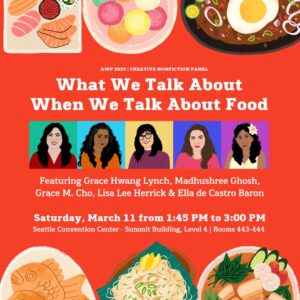
What We Talk About When We Talk About Food
Grace Hwang Lynch, Madrushree Ghosh, Grace M. Cho, Lisa Lee Herrick, & Ella deCastro Baron
Food writing can go beyond memories of grandma’s cooking or stinky lunch box scenes. Tastes, smells, and memory can tell stories about fraught families, multilayered cultural identities, and even geopolitics. These five Asian American writers weave meals and recipes into memoirs and creative nonfiction to illuminate personal and global histories. This panel discussion will explore the pitfalls of writing about food and offer advice about how to use culinary themes to tell deeper stories.
_______________________________________________________
This is a good ’nuff space between last September and now (February 2023) to say: I did stuff & had limited spoons. The flyers and updates and invitations and hem-hawing happened elsewhere on the world wide web! If there are any recordings or notes of what happened, they’ll be shared under “Events,” “Media,” or “Kapwa.” Here are a few subo and baon (bites ‘to go’):
1. One of the many reasons I work through Corporeal Writing: a beautiful gift by an anonymous donor to support sick and disabled folks. It helped many folks join our Feb 2023 “To Exist is to Flare: Loving Our Chronically Ill Minds & Bodies”:
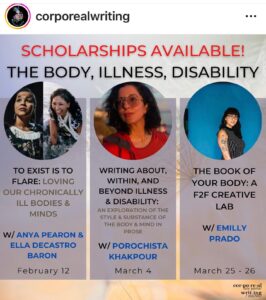
2. One of the collages I enjoyed making with others, facilitated by collage artist Jen Soong:
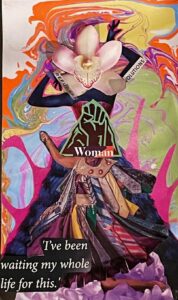
3. Several communities joined together last November for a night of deeper knowing through our senses. Sound baths, where have you been all my life?
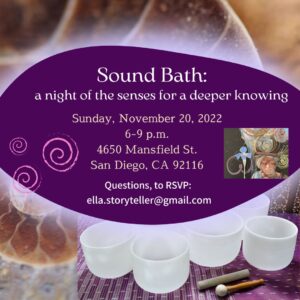
_______________________________________________________
Preview our upcoming course, “Where We Come From: Writing Your Ethnoautobiography”
We begin Tuesday, September 27, 5-7 pm PST/ 8-10 pm EST
Scholarships are available (especially for BIPOC).Full description is here.
Corporeal Writing’s “Where We Come From: Writing Your Ethnoautobiography” will begin its next generative lab cohort on Sept. 27, 2022. Come and listen to alumni share stories and art inspired* last year’s course! This was a welcoming space to preview what we do, ask questions, and engage with alumni and facilitators. Quick reflection on how it went (IMHO): AAAAHHHHHH blubber blubber words words sighs claps yells humms. These storytellers and their stories: phenomenal. See & words sighs claps hum for yourself!
(*seeded, cross-pollinated, cultivated, composted, re-potted, freed into the wild)
_______________________________________________________
“To Exist is to Flare” Reading & Art Share by Chronically Ill Folx (virtual via Zoom).
Saturday, Aug. 13, 2022, 4-6 pm PST/ 7-9 pm EST
My co-teacher Anya designs t-shirts to help raise awareness & support for fellow “spoonies.” <heard of Spoon Theory? One of our Flare readers shared about one of their safe spaces, where loons are, “calling me home.” Emily’s written and visual art are beautiful!

Check out other colors along with many other Anya designs. Shop, send, wear & support folks with chronic illness: Anya Pearson. Urban Haiku
Join us for a time of poetry, CNF (creative nonfiction), memoir, art by chronically ill folx (of mind, of body) who are part of the Corporeal Writing’s “To Exist is to Flare” community. For those who can donate, this is also a fundraiser to support future attendees (it’s expensive to be sick!) What dynamic celebration and medicine, a sacred moment to recognize ourselves in each other.
_______________________________________________________
UPDATE: new start date for 2022 Cohort!
Virtual Six Bi-Weekly Tuesday gatherings
Begins Tuesday, September 27
Where We Come From: Writing Your Ethnoautobiography
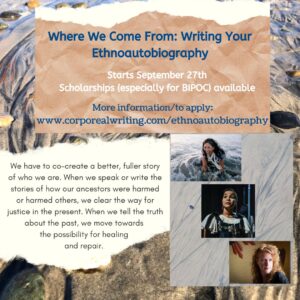
Ravyn Stanfield, Anya Pearson, and I are co-teaching our second yearly cohort that holds sacred, generative, healing community to explore each of our ethnoautobiographies. This is the work of our lifetimes. This is the way we heal backwards and forwards.
Here is some of the course description. Check out the link for more details. We offer sliding $cale for Justice, Equity, Diversity, and Inclusion.
Questions? Email me at ella.storyteller@gmail.com
WHAT: A six-week bi-weekly generative Collaboration
We have to co-create a better, fuller story of who we are. When we speak or write the stories of how our ancestors were harmed or harmed others, we clear the way for justice in the present. When we tell the truth about the past, we move towards the possibility for healing and repair.
Ancestry gives us heritage: “traditions and practices that inform how we move through the world.” Who are our ancestors of blood, love, and spirit? This circle will facilitate and explore our ethnoautobiographies** through place, ancestry, body, seasons, and story.
Embodied and community-activated stories not only redirect from damaging neural pathways, they promote neurogenesis: our brain cells can pave new, anti-racist and truly restorative paths as we dare to practice. As we decolonize and re-indigenize core values that de-center and dis-engage with dominant culture (white supremacy, patriarchy, settler colonialism, capitalism) we create a more inclusive one. We become “radically present” and better care-givers of each other and the planet.
**as inspired by the work and teachings of Dr. Jürgen Werner Kremer and Dr. Leny Strobel
WHEN and HOW: This collaboration contains two parts: We will gather on Zoom for six live, co-creative meetings (with recordings for those who cannot attend live). A final celebration, TBD by participants, after the six meetings.
WetInk (our rich interactive online platform) will be used to build community, share, explore ideas and engage with each other. (WetInk will not be required for critique or hierarchical feedback).
___________________________________________________________
To Exist is to Flare: Loving Our Chronically Ill
Bodies and Minds
with Ella deCastro Baron and Anya Pearson
A 4-week generative lab over Zoom (recordings available)
Thursdays in May: 5/5, 5/12, 5/19, 5/26 — 5:00-6:30PM PST
In February this year, Anya and I held space for over two dozen folks around Turtle Island. They showed up just as they could in that 3 hour webinar. One person was in her light-less attic with a self-rigged “migraine helmet” on to ease her pain. Another’s camera showed their mid-century modern art wall; they propped their body, gently re-positioning to ease an inflammed back. Many offered their tender, tired, tenacious gazes to one another. The Chat filled with sacred offerings. I felt a holy surge (hole-y, yes, and wholly) when people named their diagnoses at their own discretion. Hundreds of brave, threaded words through our stories, a basket held together by compassion.
“I see you.”
“I feel this so much.”
And when we invited each person to ‘break the spell’ and make known something they want for their wellness, we held open arms and space to believe with and for them.
“I want that for you!”
“Hell yes!”
“I hear you. You deserve it all.”
Witness makes repair more possible because a community can build resolve to love ourselves, to try again, to show up however we can.
So here we are. We are co-creating, really, inventing new ways to be together. From philosopher, teacher, and co-traveller in these liminal spaces, brother Bayo Akomolafe: “Remember that disability is the condition for community, not wholeness. Communities are always practices in crip-ontologies. If we were whole, we wouldn’t need each other.”
We invite and welcome you into this space with us. Read more details here. Sliding $cale in the JEDI spirit (justice, equity, diversity, inclusion).
_______________________________________________________
Salo-Salo: Virtual Storytelling Feast for Brown Women’s Herstory Month
Monday, March 7, 2022, 5-7 pm PST/ 8-10 pm EST
(See Media page for YouTube recording)
This Salo-Salo will offer compelling, imaginative, sacred, unforgettable storytelling by Kimberly “Kimchee” Kaminsky, Vex Kaztro, Rosario Rosario (Rose Sabangan), and Gimi Willie. These Creatives embody stories woven with the Philippines, transracial adoption, family, mixed ‘race’ complexity, Indigeneity, pirates(!) and more.
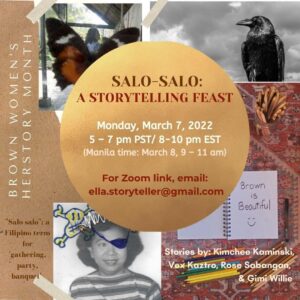
To Exist is to Flare: Loving Our Chronically Ill Bodies and Minds, Sunday, Feb. 13, 2022, 1-4 pm PST over Zoom. Co-taught by Anya Pearson and Ella deCastro, fellow ‘sickies.’
Check out more details, including sliding $cale, at Corporeal Writing.
What ails us? Maybe it’s easier to ask what doesn’t. These days. These months. (We’re going on year three of Global Pandemic! the rippling effects from March 2020 feel more like seismic ruptures, permanent de-stability and dis-ability for our systems and bodies.)
Anya and I were meeting about our other co-taught community course, both of us in flares. We “get” each other as BIPOC, and also as people who have relatively “invisible” diseases. Sometimes we need to be in a ‘room’ (crumpled on the floor, wrapped in bandages) where “complaining” isn’t whining. We gotta decolonize that ish! It’s relational, not transactional.
Chronically sick people have legitimate need to share our processes & want to be listened to (without fear of un-asked for “advice”!) We need empathy for how many hours, pleas and PLEASE it took to convince our doctors to give referrals or look/listen a lil longer. Someone to shake and nod with us about all the thousands of out-of-pocket we spent trying to find relief or diagnosis, and fellow LOLSOBing at our dark humor memes. Where can we do this and feel unjudged, unpitied?
It’s kindov like “BIPOC-only” or “women-identifying-only” spaces that offer safe harbor and generative co-creative sparks. We figured, “why not make a space for others like us that at least tries to share ‘sick-informed’ love languages”?
A lot of our sicknesses are an entanglement–physical, emotional, psychological, spiritual, and as we’ve seen, societal. You get to decide if this “webinar” (what’s a better word for this? anyone?) is for you. You get to share (or not) what you’re suffering from. It could be inherited, a prolonged or recent injury, a lifelong disease, a recovering addiction, post-treatment from cancer, ongoing mental illness, Pandemic-related grief, something “inflamed” that hurts but you can’t “figure out” and neither can the experts. It could be you don’t “fit” into what “mainstream society” says is “normal” or “healthy” or “well.”
For me, my inherited skin disease (atopic dermatitis aka eczema aka modern leprosy aka forever-unsettled-in-my-itchy-brown-skin) broke my mind and body to also live with PTSD, depression, panic & anxiety disorder, insomnia (ugh). (You can see Anya’s diagnoses on the Corporeal Writing description under our bios.) I’m extra-sensitive to others who suffer in their bodies and minds because of this. How do we love ourselves just as we are–moment to moment–and can we offer this respite to one another together?
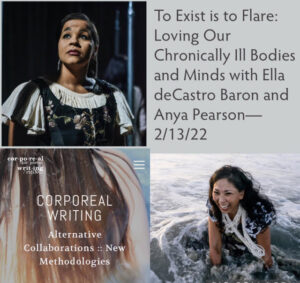
Description:
Western culture tries to teach us that illnesses have cures. We hunt for antidotes and fix-alls. Yet, those of us with chronic illnesses—in our bodies and minds—persist in the slog of hit-n-miss treatment and diagnoses in-between “flare-up” and “remission.” There’s the isolation. There are. All. The. Costs. We’re even gaslit by healthcare professionals when we self-advocate, judged by those who do not/cannot see our inconvenient, uncommon, or invisible illnesses. Our stories are messy, inflamed, transcendent, mundane, stunning.
How do we love our own sick bodies and minds when so often, we are not loved well?
We need to decolonize the industrial, capitalistic, ableist reactions to the liminalities of sickness, suffering, treatment and wellness to love our true selves better.
This virtual “sick bay” is for chronically ill people of mind and body. Together, we will resist band-aid, results-driven ways of loving ourselves. We will:
*ponder and play through somatic portals
*practice sick-informed “love languages” beyond ‘toxic positivity’ (e.g. dispense laughter, tears, and tender touch as medicine)
*honor the divergent, brilliant ways our sick bodies and minds hold and tell story
*share and listen to our wonderings, woundings, and epiphanies. NOT medical advice!
In this same spirit, we encourage you to join the meeting however you can. We recognize that how we are able to ‘show up’ changes constantly, hour by hour. Come as you are. We got your back (unless it hurts too much to touch).
For us, to exist is to flare. In-flamed, we can be our own Valentines.
To Exist is to Flare: Loving Our Chronically Ill Bodies & Minds, Feb. 13, 1-4 pm PST
Salo-Salo: A Storytelling Feast, Oct. 25, 2021, 5 – 7 pm PST over Zoom. Click here to register for the free and freeing shared meal!
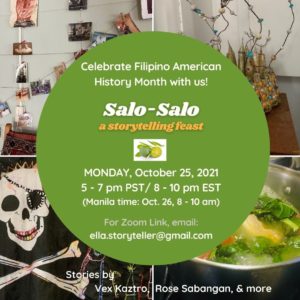
___________________________________________________________
Tending to Grief
I’m getting better at tending to grief, AKA being more fully human, more fully spirit, more Present.
I’ll be reading a bit of the griefs I’m carrying with others, within myself. If you’d like company, there are five of us sharing. It’s free to join.
Thursday, September 2, 2021
7 pm PST
“Hear 5 wonderful writers read their heart words around grief. The zoom call will last about an hour. Come listen.”
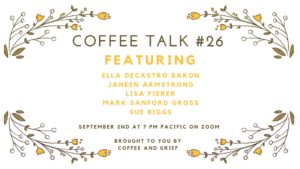
I didn’t know know that we are not designed to carry grief alone. It is impossible. I’m learning.
Earlier this month, I hosted a virtual Circle to tend to our grief. I sent a note to people I trust. It said:

Where We Come From: Exploring Our Ethnoautobiographies
Say what? I hadn’t heard of the term, ethnoautobiography**, until last year. It means to integrate our own origin story through culture, ancestry (of “love, blood, and spirit”), body, place, land, and more. It is the word, the world I had been circumnavigating for years and didn’t know there’s an encapsulating term.
The “ethno” makes sense these days right? We have to press into our full identities. The power of “auto” is that you, I, we get to know and TELL (write, share, co-create) our stories. As Philippine hero Jose Rizal said, “Know history, know self. No history, no self.” If we don’t learn and then tell our own stories, someone else will…and we’re too familiar with those caricatures, stereotypes, ~isms and all.
In January 2020, I co-produced and co-taught “Hips, Hearts, and Throats,” a beach weekend of painting mandalas, dancing hula, uncovering our truer voices (and I got to cook the food–one of my fave love languages because I also pray health, connection & wonder into the alchemy!) It. Was. Everything. And. More.
And then mid-March dot dot dot when we found out that those in-person events had to be More, right, to last us through the year of sudden-Zoom? We had to use our voices to sing life to each other over screens. We had to center our hearts and keep loosing fear from our hips. I found myself in all kinds of virtual salas (“living rooms, hall/passageways”) to figure out who I am, who we are, only way more deeply than ever. Wayfinding with dozens of “kapwatid” (kapatid = siblings + kapwa) through a course called Celestial Journeys (led by Dr. Jeannie Celestial) led me further in and down to where I am now. A healer suggested I look into a certain book with a crocodile on the cover…that led to the Center for Babaylan Studies…I bought/markered many books…I listened, joined workshops and global conferences…
…and here I am, preparing to co-teach with two brilliant artist-healers, G. Ravyn Stanfield and Anya Pearson.
This is the work of our lives. I am day-n-night dreaming about the people of culture (that’s all of us!) and those who don’t think they have any/enough (is that you?) This is the antiracist destory-ing, the fully embodied restory-ing we can choose to do together, especially for BIPOC folx.
As Resmaa Menakem calls us to, “pause…and quake” and metabolize racialized trauma. This is part of it. And there’s more.
I’m praying/calling out for those of you who feel the same curious longing for More dimensions of your identity, or maybe a tiny gravitational force is weighing down your thumb to click, to check out Corporeal Writing’s community course that starts July 5th: “Where We Come From: Writing Your Ethnoautobiography.”
The course description has all the dates, each meeting’s theme, cost, and more. There’s a short list of questions so we can make sure the space, commitment, and resources are mutual for all of us. Here’s a bit:
“We have to co-create a better, fuller story of who we are. When we speak or write the stories of how our ancestors were harmed or harmed others, we clear the way for justice in the present. When we tell the truth about the past, we move towards the possibility for healing and repair.
Ancestry gives us heritage: “traditions and practices that inform how we move through the world.” Who are our ancestors of blood, love, and spirit? This circle will facilitate and explore our ethnoautobiographies** through place, ancestry, body, seasons, and story.
Embodied and community-activated stories not only redirect from damaging neural pathways, they promote neurogenesis: our brain cells can pave new, anti-racist and truly restorative paths as we dare to practice. As we decolonize and re-indigenize core values that de-center and dis-engage with dominant culture (white supremacy, patriarchy, settler colonialism, capitalism) we create a more inclusive one. We become “radically present” and better care-givers of each other and the planet.”
**as inspired by the work and teachings of Dr. Jürgen Werner Kremer and Dr. Leny Strobel
Is it our time to do this work together?
___________________________________________________________
Summer Solstice–Company on the Longest Day?!
You’re all invited! Sunday, June 20, 2021, 5 p.m. PST/ 8 p.m. EST
Sign up for the free Zoom event here. Any donations will go towards scholarships for BIPOCs to attend Corporeal Writing collaborations!
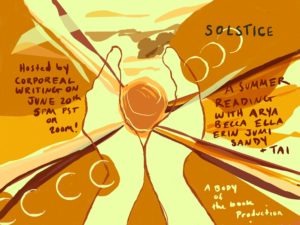
Poster art by Becca Bell, one of the Body of the Book readers!
I mean…hasn’t the last 14+ months felt like ONE LONGEST DAY. Or Daze? In the worst and best and long-suffering ways, mosdef. [Is it okay if I don’t summarize the “worst” or “long-suffering” this time?] One of the “best” is that I was awarded sabbatical last Fall semester–the first Adjunct in our district (phew! ’bout time…my 16 yr. adjunctivitis was flaring up!) One of the terms: to finish the draft of my next book.
In 2018, I wrote the first draft in an intense (good kine) intensive called “Memoir, Memoir Lab.” Nine writers met weekly and wrote memoir drafts–about 80K words in only THREE months (w.u.t. Yes it happened. Mine was 77,069 words.) And I learned that there’s a reason memoir takes many years to write. I felt like I carved all the letters in about seventy thousand of those words with my broken fingernails…in the sand at high tide…between waves and hermit crabs smudging through my Filipina block lettering and swirly whirl in cursive. IOW, it’s a LOT of emotional and storytelling and spirit and communal and potato chip labor…AND as I learnt with my new sister-friends, Mexican mocha and slices of pie.
I had to metabolize everything that I conjured, tended to, and got down on the page. I did not /could not look at the 77K words again for at least nine months. As it should be. Gestation and all.
When I was rewarded sabbatical, I had to take two classes for professional development. I applied to Body of the Book through Lidia Yuknavitch’s Corporeal Writing. (I have so much more to effuse ’bout this mermaid…[bubble bubble] for another time [froth starburst ‘lip wobble’]…or you can sense her courage tendrils in between and holding my latest words and ways embodying ’em.)
Oh wait. Rewind. Before last Fall, “shelter-in-place.” And I had forgotten I even applied. Or that I was granted.
So when the Summer 2020 work e-mail reminded me, it all made too much sense. Senses. Too mach. For several months, on Monday nights, 8 writers plus Lidia “swam among” each others’ book bodies/oceans. Marvelous. Word and imagery and language dunked, drunk, willingly drowned.
We finished meeting earlier this year with Lidia, we BoBs (our cutesy nickname) began meeting & supporting each other through Next Steps. Books are not meant to complete alone. How do you harness the energy solo? I can’t. I don’t want to. It’s not how I’m made anywhat.
Here we are: keeping each other company, and offering you a Corporeal container to spend a bit of the Summer Solstice with us, in these waters! Come hear a bit of the 8 different book worlds galvanizing a path through and towards the All-ness of Story. All the info is above (under the title in case you’re a sampler!) and it’s here too for those who linger, like me.
Sunday, June 20, 2021, 5 p.m. PST/ 8 p.m. EST
Register here for free Zoom event. Donations gladly accepted and will support BIPOC to attend future Corporeal Writing collaborations (including one I get to co-teach! Here’s a peep (more to come)!
___________________________________________________________
Our Stories are Antidotes to Anti-AAPI Hate & Violence
Filipinos and other Asian and Pacific Islanders are treated as an “invisible” and “model minority,” so to have been hyper-visible as murder victims in Atlanta recently is…startling and distressing. It has unmoored me and many of my AAPI sisters. During the Coronavirus Pandemic, the longer and deadlier pandemics of racism, xenophobia, misogyny, and Christian purity culture pulled off All. Of. Their. Masks.
I’m called to share some of what it means to live as an Asian American woman who is constantly exoticized, minimized, and erased. Even more, I’m galvanized to share what it means to be resilient and to maintain our core values of service and hospitality, in the throes of viral exploitation and dis-ease.
PLEASE join me and several Asian American and Pacific Islander authors as part of the anthology, (Her)oics: Women’s Lived Experiences During the Coronavirus Pandemic.
(Her)oics Asian American Writers’ Experiences in the Pandemic – May 16, 2021 4:00 PM PST (event registration removed)
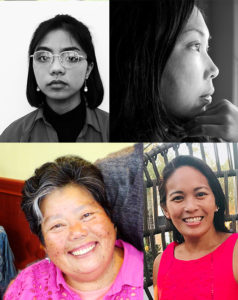
Given the challenging news of ongoing anti-Asian sentiment and violence, we are very proud these writers have shared their work with the anthology. We will gather with gratitude, praise their stellar writing, and embrace these humbling stories.
Sharing excerpts of their essays:
Hannah Agustin, Whitewater, WI. On Isolation;
Ella deCastro Baron, La Mesa, CA. Bahala Na;
Shizue Seigel, San Francisco, CA. Prayers for a New Reality;
Joanna Mailani Lima, San Diego, CA. Sacred Story Stitching
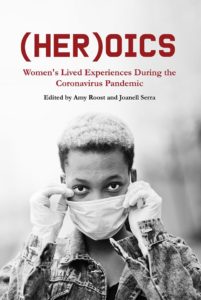
“Why are there so many Filipino nurses in the United States?” was the headline of so many major news outlets. For me, it’s personal. My sister and many of my cousins–all nurses–inspired my contribution to this vital anthology, a collection of 52 stories of women’s labor, love, and longevity.
As Lidia Yuknavitch, wondrous creature, author, friend, says: “The homefront has always been inhabited by women, including anyone who identifies with and enters the space of “woman” – caretakers and home keepers and compassionate community builders. This collection reminds us how the heart warriors never give up or in, which is the only reason we have a chance.”
Support the anthology, the feminist press, and the women in our lives by ordering here or through your local bookstore.
Listen to a bit of what it means to be a woman of color in this pandemic on this podcast, Surviving Racism in a Global Pandemic: Being Black or Brown in America during the Coronavirus
Info: Alicia Mosley and Ella deCastro Baron, contributors to the anthology, (Her)oics: Women’s Lived Experiences During the Coronavirus Pandemic, and Joanell Serra, coeditor of (Her)oics, (Pact Press, March 2021) will discuss their contributed stories: “Mosley’s Mothering while Black during the Pandemic” and deCastro Baron’s “Bahala Na.” In conversation with Pam and Jaynie, they will consider the impact culture and race had on their communities’ experience of the pandemic.
___________________________________________________________
Sand in Our Minivan
August 6, 2019
I gotta come clean. I don’t know how to consistently be my full, honest self in my writing. I’m a “both/and” advocate yet think if people see all the sides of how I really think, I’ll end up being either/or to them. Either safe or too mouthy. I don’t want to piss off the more ‘conservative’ people I love and respect. I don’t want my ‘progressive’ people to think less of me. [Even though hellooo, no one is thinking more…or less…of me than my own paranoia.]
Another writer admitted how challenging it is for her to write “openly” about faith. She can write about the toughest subjects: poverty, sexuality and the body, whatever injustices America needs truth about. The undersides, the invisible, the controversial. But when it comes to faith, she wants to make sure she’s not perceived as too “churchy.”
She says, “I like to consider myself a thoughtful person, but my entanglement with an institution so heartbreakingly flawed made me question just how smart or forward-thinking I was.” **
Daaaang. That’s just like a Filipina American I know who’s flaring nostrils & scrunching face is texting, dis me.
This author advises to “go to where the silence is.” Hard to do, but if I believe “faith without works is dead,” the work of writing is harder to disavow. It isn’t who I want to be either.
Here are two different writing takes, both true, inside the same me. I contribute to a newsletter of a local women’s leadership collective, Lifestreams. Most of the membership are Christians of a demographic I did not grow up with on the naval base in our working class [read: many shades of brown] town. As different as we are in our lifestyles & politics, I value these women. So much of what happens in this group has sustained me during these difficult years since the Election. [we need more of this overlap in the country & world!]
In “Ekphrasis, May I?” I felt authentic writing about sand grains as Love notes from the creator. I really dig um, digging into scripture as art (also as necessary as digging out scripture as warts). The silence I’m going to here is that of a condemning, unloving voice. God is not made in our image—stuck in a critical spirit of judgment and comparison to each other.
That “us vs. them,” “winners and losers” is a dangerous binary. It’s what Jesus aimed to dismantle. We can and should be hearing love notes all the live long. We should be saying with our actions & words, “I am so happy you are who you are.” It’s about, more than we can “think or imagine,” that “there is always enough” and the good news is none are excluded. It’s “win-win.”
++++++++++
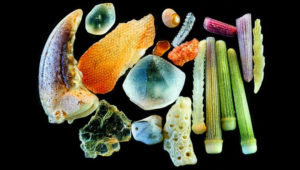
image: from sandgrains.com
“Ekphrasis, May I?”
Okay, ready for your Greek word of the month? The two dollar word you can utter nonchalantly at the next dinner party, or with a walking partner?
[you, raising an eyebrow that pulls up a corner of your lips] “The other day, for my time with God, I did a little ekphrastic journaling.”
[whoever you’re talking to] “Oh, wonderful.”
[same person, nodding] WUT?!
Ekphrasis, “to describe,” comes from ekphrazein, “to recount.” It is an inspired reaction to a work of art. Usually, a person studies or meditates on an engaging piece (a sculpture, a painting, a photograph, a scene) and reacts with their imagination and spirit. Writing and art teachers use this exercise—ekphrastic writing—to have students connect with art, to go beyond it by exploring deeper meanings. It can also cause us to co-create new material out of our imaginations!
We should try it often and with abandon. As a teacher once advised [with my tweaks], “Write drunk [in the spirit!], edit sober [or not at all!] Look at a famous piece of art (like Van Gogh’s “Starry Night”) or something in your yard (a bird, a succulent, fresh dirt) or pull up one of your smartphone pictures (a sunset, a silly selfie).
Let yourself look at, interpret, praise, inhabit, confront (!), speak to or speak with this subject. Give yourself into an ecstatic moment. Beyond a little pause in our day, we know this can heal and propels us with vision into our destiny.
Ekphrasis is a lot like when we study scripture. We treat the words of God as pieces of inspired art. The Rhema (the spirit “now” word) behind the Logos (the physical recorded word) connects with us. And if we can open ourselves to what Holy Spirit wants to reveal, we find ourselves in worship with worlds of wonder!
Yesterday, we went to South Mission Beach late afternoon. (Pro-tip: most people are leaving, heat is dissipating, and you only have to apply sunscreen once). We pulled a wagon with boogie boards, snacks, towels, and beach chairs. We thought we’d spend a few hours cooling off, decompressing and chatting with friends before going home to check off more of our Adulting “To do” lists.
The kids kept jumping back in the ocean. We didn’t stop them. We swam, strolled, sat, too. We stayed until 9 p.m., grabbing slices of New York style pizza along the boardwalk, getting home too late for anything “responsible” other than quick showers and bed!
A day like that always reminds me of why we pay the rents we pay here in “Sun Diego” [or “Sandy Ego”!] Grounding myself in the wet sand, jumping through waves, the seaweed braiding itself around me: this is walking into a three dimensional artwork. In between Lifeguard towers 12 and 13, I was reanimated in that very small but profound beach patch.
This morning, I thought of Psalm 139 and how God has tangible, specific thoughts of me that outnumber the grains of sand on the whole planet, not just one lifeguard tower’s span!
“Every single moment you are thinking of me!
How precious and wonderful to consider
that you cherish me constantly in your every thought!
O God, your desires toward me are more
than the grains of sand on every shore!
When I awake each morning, you’re still with me.”
(Psalm 139: 17-18 TPT)
I googled “magnified sand grains” and here, the ekphrastic moment opens. This is an invitation to think about sand itself as divine art.
Look at each of these grains of sand. EACH miniscule grain is a work of art. (I invite you to look up more images. Copy and save one that stuns you. I mean, can you even fathom?!)
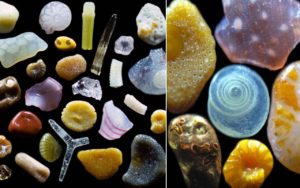
image: from sandgrains.com
Since I was at the beach, God’s thoughts started there and kept going. For each complex grain sculpture, one thought. Here’s what I perceived:
I love how you still giggle when you catch a wave.
I love that when you’re exhausted, you pop up and say out loud to no one, “Two more waves” before you stop. I’m the one who suggests, “FIVE more!” and you agree!
This salt water is healing your skin. It stings on the tender places. Keep swimming until the pain stops. Remember how I did that for you in Hawai’i as you recovered from sickness? I’m still doing it.
I love that you bring a book in your backpack even if you never pull it out.
Today, your family is healthy. I celebrate this with you!
Staying present is worth it. It’s really hard for you, I know! I made you!
I really like that you’re the grown up who brings red velvet cookies and pulls them out when everyone is ready for a treat.
Kids have no sense of time. I want you to abandon your sense of time, too.
It’s so good that you’re trying to stay curious. I’ve got so many surprises for you!
Do some ekphrastic writing about what God is thinking of you, this moment, on the stretch between Lifeguard stations 12 & 13. Look closely at each grain of sand, at how intricately it is designed. These are how elaborate God’s thoughts are about, to, and through you. Make a list of thoughts inspired by just five or seven or ten grains. Think in first person, from God to you.
Later, re-read what you record. Maybe write an ekphrastic sand grain thought-list to someone who needs to know how loved they are today.
Try to imagine these thoughts multiplied by SO many more—a number we can’t quantify—each a precise, matchless longing to love you and those around you.
“Every single moment you are thinking of me!
How precious and wonderful to consider
that you cherish me constantly in your every thought!
O God, your desires toward me are more
than the grains of sand on every shore!
When I awake each morning, you’re still with me.”
++++++++++
The second piece, “Minivan Loop,” is from an online poetry class on our different senses. This assignment asked me to “listen.” Hear what comes up and record it. This was in May during a minivan loop that felt more and more treacherous driving over detonated political land & spirit mines.
[metacognition mome’: I’m burying the lede! This is the tougher piece of myself to share!]
I’m going past suburban soundscapes to what is vibrating inside of me. The notes are unmelodious. It’s a crash of cymbals: what I want to do and what I believe I can. I’m choosing to believe, that’s okay, too, for now. The sounds are a start. They’re silencing “white noise.” God, I hope.
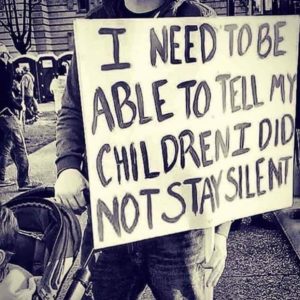
image: from Digital Smoke Signals
++++++++++
“Minivan Loop”
What I’m not hearing from too many Christian friends:
“We were wrong about Trump.”
I force myself into heart-centered breathing,
CPR on myself, compressions to the chorus,
AH-ah-ah-ah staying alive…staying alive…I count
to eight, slow exhale. What I’m still driving away from
these days: church.
In between school drop-offs, groceries, pick-ups and shuttles,
extra hula dance practice, I stream stand-up comics.
Youtube clips animate their faces, slapstick.
Their names alone, a polyphonic song on full, wide
lips: Fahim Anwar, Anjelah Johnson, Ali Wong,
Hasan Minhaj. The comics invite me: laugh at
our Otherness. “Laughter is buoyancy;
buoyancy, hope.” I join with audience giggles,
howls. We are riotous, ecstatic.
National Public Radio reports: the flu is spreading among Central Americans quarantined in Texan hotels. As soon as they are not contagious, our government will ‘seek’ their asylum in San Diego.
The largest Iraqi war refugee population in the United States is here,
our part of east San Diego, in El Cajon, “the box.” I roll rusted
carts alongside Chaldeans in Vine Ripe market, order fresh feta,
marbled halvah—the dense, honey-sweet,
sesame ‘fudge’ for celebrations.
I come from full-storied living rooms, cousins and cousins of
cousins. I visited Uncle Willie, father of 14 kids, in their
relocated, one room four-year-n-counting “temporary”
shelter after Mount Pinatubo erupted in 1991. The volcanic
mud flows, lahar, sunk homes in hundreds of barangays,
240,000 families displaced in Mama’s province, Pampanga.
Yet, as we visited, I sensed no poverty
spirit, only felt and heard the joy, relief of family
in their broken English. Ten years later, many of these cousins
immigrated, re-creating homes in California and Colorado.
I unpack groceries into our stainless steel fridge. New ice cubes
clatter into the freezer tray. Still alone, I turn up the audiobook,
Heavy: An American Memoir, hear of a “train” pulled
on a teenage girl while the 11-year old protagonist waits,
confused, in the hallway. The author’s Southern Black
American dialect intensifies the weight of this
truer America. “Fuck.” I blurt. “Shit,” I start crying.
Involuntary utter, a speaking in tongues.
A thing I started to do after the Election: count how many
people can sleep on our floors. I imagine one yoga mat size
equals one refugee. Ten in the living room, another ten
in the family room (more if they are kids). But I don’t invite
seekers in person, don’t offer shelter
from lahar. I count but don’t know how things
add up nowadays. Instead, I fill the gas
tank, ping between audiobooks, Modern Love
podcasts, stand-up comics. I sigh, laugh, cry,
rewind. I pack our seven-seater minivan,
our three bedroom house with discordant,
bustling stories of people trying,
trying to stay alive.
+++++++++++
[**the article, “On the Pitfalls and Power of the Religious Essay” by Sonja Livingston is from Literary Hub, Aug.5, 2019]
___________________________________________________________
More Fully Human
May 11, 2019
“What is saving my life now is the conviction that there is no spiritual treasure to be found apart from the bodily experiences of human life on earth. My life depends on engaging the most ordinary physical activities with the most exquisite attention I can give them. My life depends on ignoring all touted distinctions between the secular and the sacred, the physical and the spiritual, the body and the soul. What is saving my life now is becoming more fully human, trusting that there is no way to God apart from real life in the real world.” ~Barbara Brown Taylor
________________________________
I took a lot of weepy walks after the 2016 Election. Looping the beach, our hilly streets, or the Lake, I’d listen to long distance church sermons on my walks. Nature + Exercise + Sermons = Go(o)d. I re-listened to certain sermons 3, 4, and 5 times because the preachers promised I am an overcomer! I am a child of Light! Darkness is destroyed when I walk into the room! I get hyped following these [walking loop] marching orders.
The Sun and The Son. I soaked all of it in. The charismatic Vineyard movement’s theology grew me to love the electric jolt of Holy Spirit zipping through my chest, arms, fingers. Sometimes my buckly knees tumbled me down slain, synapses sparking spiritual. Ecstatic experiences aren’t easy to come by (at least not sober). I crave this charge.
Guess I thought I should listen to sermons. That’s how I took my Jesus vitamins. Since our local church shut down that same November, I had to fill my “clay jar” with familiar “talking head,” “sage on the stage” exhortations.
Soon, I discovered the same pastors I streamed continued to support Trump. I really thought/prayed/begged that “time would tell,” that as all these church leaders witnessed this administration’s unrelenting…everything…it would clarify their vision, and they’d stop explaining away grievous non-Christian [non-ethical, non-legal] behavior, or pointing to “I had a prophetic dream” as a blinding green light. It didn’t happen. Do I have to say how disorienting, how disappointed, how betrayed this made, makes me feel?
This cognitive dissonance offered me a gift of perspective. I turned off. I deleted.
Most of my listening airwaves have instead been filled with resilient student stories on campus & storytelling podcasts like the Moth, This American Life, TED Radio Hour, Modern Love, and lately, Rough Translation. Sprinkled throughout, stand-up comedy clips (Anjelah Johnson does a GOOD Filipino grandma accent! Praise Be!) I’m a part of a leadership collective, Lifestreams. The teaching there is Something More than any church service while resembling parts I miss (worship, intercession, small groups, faith family).
Last weekend, as our family danced and celebrated Hawaiian culture at De Anza Cove, I heard the news of Rachel Held Evans’ death. I went numb. I couldn’t sleep. I read about her impact. She challenged the institution, truth in love. Friends texted and posted.
We went to work. We packed lunches and took our kids to school. More insomnia; I interceded for her babies in the quietest hours. I cried and read more about how she made space at the table for misfits and outcasts. I spaced out.
Along with so many on this planet, I simultaneously believe she’s in paradise as part of a much grander Love story that will ultimately make sense to us all, and, I grieve.
I felt ready to ask for and listen to thoughts on faith again. I can’t return to the Old, to ‘business as usual’ sermons. I wanted recs for progressive Christian podcasts. Friends shared titles representing diverse voices on wondering and wandering.
I’m beginning to listen. I’m not less confused, but I do feel kinship. I’m in the dark, but I’m not consumed by it. I imagine Chris would rub my neck and channel his beloved author, Not all who wander are lost.
I listened to a “For the Love” interview with RHE. She quoted Barbara Brown Taylor, an Episcopal priest who once left her faith (and, she says, it pursued her). RHE used to rely on these words:
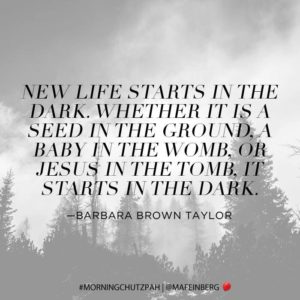
In my head, I know this resurrection power comes out of dark. Yet, my default faith is to resist the dark. Barbara Brown Taylor introduced the idea of “lunar spirituality.” It is very much not the “solar spirituality” I have always found safety in. Y’know, where all the lights are on all the time (even the wasteful artificial incandescents.) Is this why I’m so annoyed that ALL of my children including ALL of my husband leave ALL the lights on?! I do it with my faith!
Why am I afraid of the dark?
I don’t know.
I can’t answer that. Yet. (<==growth mindset, holla!)
Barbara Brown Taylor is known for asking this, too: “What is saving your life today?”
(Urm yes, I downloaded her audio book, Walking in the Dark. She’s hitting bullseyes for me).
I can try to answer this.
For the last two plus years, any time I sit quietly for a minute, I feel my vertebrae stack, slack and settle. My breath throttles, then idles. I press Pause on my body’s kinesthetic jibber jabber. The weightiness behind my eyes gutters, splintering down into my ribs.
It hurts. I start to cry. I don’t know why exactly. I don’t need to. My mind is in the dark. Not my body. It knows.
This is a luxury, this Pause. I can cry every day if I made space for this.
These tears, I think, are my somatic salvation.
On the Enneagram, I’m a 7, the Enthusiast. I am ready for whatever comes next. I’m also prone to being scattered. I’m your Yes, let’s! girl. In college, the “laugh now, cry later” friend. This straddles and kicks at, blurs the lines of what many consider sacred and secular, pretty and potty mouth, adventuresome and aimless. I’ve matured [enuf, so says my counselor] and am a more reliable ‘shoulder to shoulder’ sister. Community covenant keeper—in death, in life, in mystery.
I don’t want to know another way. One of the meanings of my name, Ella, is “all.” Through the decades, I’ve taken it as an invitation. Like Jesus, with Jesus, I am invited to bear witness to all.
For all of this vitality, know what though? I have trouble connecting with my own heart. I get clogged in my head. People might say, “But you’re so full of heart!” It seems so, but it’s a reflection of others. I position myself around those whose hearts I emulate. I desperately want more of my own; I even took a HeartMath course to learn how to breathe and discern from this organ that does, in fact, the most decision-making in our bodies (it’s not our brains! First heart, then guts, and then our brains!)
My friend Stephanie made this alcohol ink heart. A thousand years ago, I drew a similar medical heart as a Valentine’s Day card for my boypren. Steph’s is more authentic IMO because she let her abstract art echo-locate the heart beating. (I was trying to make a guy like me, a lil Hallmark witchcraft.)
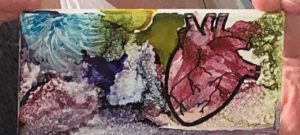
Gives me tha-THUMPS tha-THUMPS.
I confess I don’t like the cliché, caricature heart shape unless a kid draws or cuts it out, or it’s 5th graders’ BFFs half-jagged-heart necklaces—one half for me, the other half for you!
Grown-up couples, fingers C-shaped around a setting sun after a marriage proposal? Bubble pink art work on canvases, mugs, event posters? Blech. Phht. Meh. It’s overdone.
Wouldn’t you know, on the way to the parking garage on campus, there are lit’ral heart leaves.
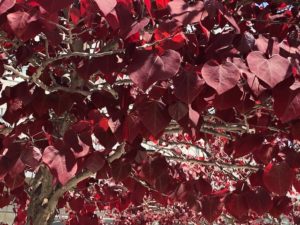
I lost several minutes standing under these. The veins, the blood. Iron-red hearts. Beautiful.
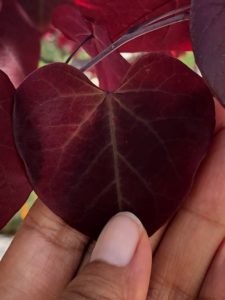
I am learning heart-speak by mimicking others who speak it fluently (like this tree). In language acquisition, it takes 5-7 years to be proficient. Maybe there’s a Rosetta Stone way, but I believe the holiest way to learn is by becoming more fully human. Yes, and. Both, and.
I shared this new-to-me idea with trusted friends: I want to explore this lunar spirituality. Not the despairing dark. This is darkness that is part of a whole day, a whole life, a universe.
Life happens in the dark. We rest, restore. We dream. Roots deepen. A seed cracks open. The womb gestates. The tomb vibrates. We can see stars. Love sings over us. The moon waxes and wanes. The sun will come up, but for now, it’s dark.
This risky idea might be saving my life today.
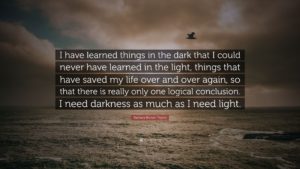
___________________________________________________________
The People at the Table
April 19, 2019
It’s one of those weeks where on Tuesday at 11:45 a.m. I was all, Whew, TGIF!
That’s the level of Ready-For-Next-Anything-Please I’ve been feeling. Not for any one reason.
This is what I heard God say. I typed it in my iphone, on the “God notes” page: “People. It’s about people. Breaking bread (matzoh!) One word, one bite, one hug, one raised clinked glass, one table, one prayer for freedom. One person inviting another to the same, one table. The table expanding for more to sit.”
[Before you keep reading, and because what a shame to waste a joke–if you’re not aware, Filipinx also call ourselves “pinoy” or “pinay.” Scroll on.]
Pinterest interpretation:

Pinoy-terest translation:

The gift of exhaustion? Besides hearing voices—Yahweh’s included—I entertain comical, emotional tantrums, Netflix numb before bed. Tell myself it’s okay, you’re okay. I have enormous privilege in this world. I know this (thank God). Write a gratitude list. Then, I get quiet. Fortunately, it fits well with Holy Week. Been listening to the Holy all around.
This will be my 19th Passover Seder. Most years, we host a full house of friends and family. My prep involves shopping and setting the tables; chopping ‘n slow cooking ‘n roasting ‘n souping ‘n stirring. Passover is a bridge to Chris’ Jewish heritage. He thoughtfully prepares the Haggadah (the narrative of the Israelites’ Exodus from Egypt) with guests’ names as readers. We take time to note who, in this world, especially needs to hear and experience the story of freedom from bondage this year. So many too many.
I love it all, down to the moment we celebrate in light of Jesus as the Passover Lamb. Hybrid story-ing, like our mixed family. Some ask if we’re Messianic Jews. Nahw, closer to non-denom’ Jesus followers who integrate the Story.
This Story is my “favorite holy-day” to get quiet, listen. As I cradle two of the biggest, briskety Costco briskets, a hefty bag of rainbow carrots to roast and swim in matzoh ball soup. As I grip square, concord graped bottles of Manischewitz that evolved on my palette over time, from cough syrup to sacred…syrup ;0) Still checking off the lists in between work, parenting, wife-ing, hula practice.
This weekend is a full-er Reflection: Redemption, Resurrection, Remembrance. (Don’t forget this week’s other RRRRR…..Redaction—a different kind of “set apart,” secular sacred for some. Swiss cheesy Hole-y.)
But I had to get to the real TGIF calendar day. So in class, I got quiet as our English class worked on their timed essay. We had rigorously practiced how to craft this specific rhetorical analysis and play the Ivory Tower transfer test game. Everyone, game day and game faces, ready.
One by one, students turned in their essays, proud and relieved. The young woman who normally raises her hand to share all the answers handed me an incomplete essay.
“Oh. Is this finished?” I asked, calmly confused.
She began to toss a word salad at me. I stared at her fingers pointing up and down the paper, as if directing an army of block printed letters to stand at uh-ten-SHUN! Well-dressed but shell-shocked word soldiers, standing 32 shoulder-to-shoulder lines down a page [i.e. a whole essay with no paragraph breaks]. A sharply dressed but aimless army. Not one following order.
I smelled the alcohol. I pretended I didn’t. Said instead, “If you want to take the rest of class time to add more, you probably should.”
How could I know why she drank at 8 in the morning before class (or why it was evaporating her skin from a soaked night)?
When she tried and couldn’t, I acquiesced, “Okay, turn it in and see what happens. Good thing this is a low stakes practice for the transfer exam.” She nodded, packed her bag, left.
I kept at reading everyone’s essays, snapped back to my seated paradox posture of: how.can.I.better.support. and how.there.will.always.be.essays.ad.infinitum.
“Essay” in college means “hella annoying assignments” for both students and professors. In French, it means, “to try, attempt.”
Also: a trial, a weight.
The last essays I read that day, more word worlds: a young man with cancer; the pregnant teenager forced into homelessness by her outraged parents; another who traveled outside of the country for the first time and told me, “There’s a whole world out there. Knowing this changes everything.”
+++
I tried for an inspired quiet in my Lake walk as I listened to a new-ish podcast, “Rough Translation.” I cried the kind of expanding tears from what a story can do to me. The episode, “War Poems.” (The title alone HOMG!)
I despised History classes in high school. It had a lot to do with rote memorization. It got worse when our 11th grade teacher tried to make me interview my Papa about his experience in the Vietnam War. I refused and gladly accepted the “F.” But Mr. A insisted I complete the assignment because it was a “valuable experience.” By the time he ‘got’ how most of the Filipino kids’ dads were Vietnam Vets, that we were ‘taught’ to leave them alone about That Time & Those Ghosts, I also learned failing an assignment didn’t have power to shame me. All to say, I’m late-blooming to understand how history—world, my own—is “valuable.”
Oh, yeah, why the podcast helped me Listen.
It references General Petraeus, a commander of American forces in Afghanistan during the war against ISIS. About ten years ago, he promoted a “new” tactic: he told American soldiers to build trust among the Afghan people. He advised Americans to take off their sunglasses, connect with the locals, be “a good guest” meaning “drink lots of tea.” RADICAL counterinsurgent strategy: get to know people. Don’t just speak their language. Listen. Speak their culture.
For some American soldiers who took these Listening Orders to heart, it meant learning ancient Afghan poetry as a bridge. An American captain who is fluent in Dari (a common language in Afghanistan) urged the military leaders to learn their poetry. She recited a 13th century Afghan poem on how all of humanity is one family.
She said of her time in Afghanistan, “I have never spoken the first words of those verses to an Afghan and not had them reply with the rest.”
(If anyone listens, there’s some nitty gritty! If you get to the end, you’ll know why I cried.)
For the rest of Not-TGIF days, I asked God more or less, What’s Up with This? The whole thing, the Holy (and Hole-y) thing: how the break up with Church feels good and awful. How I recognize stages of grief, but the nuances are sneaky sabotage. I’m unnerved. Can’t track. I feel like a disordered essay in my body—aimless army. A trial, a weight.
How disappointment surged when an email invited me to support a shiny ministry called, “Once Gay” with [redacted hole-y] testimonies of people who are no longer broken in their gayness (an exercise in confirmation bias). That there’s such a policy, “open but not affirming” for any LGBTQ person who walks through the doors.
What will Easter Sunday look like in these visitors’ eyes? Highly prayed-up & produced services as faithful members are outnumbered by “holiday in” Christians (and curious “pre-” and “post-“believers). Who will invite each other to tea, to the table? Who will say the opening line of, “we are all one family,” get quiet, and listen?
Let me collect my leaky faith-politics and say about myself: I need to do a lot more listening.
Christians call it Good Friday. I wonder if “good grief” came from this version of “good” because Jesus was crucified and buried. It’s only “good grief” because of Sunday’s resurrection. What about Saturday?
The power of Saturday is the Waiting.
This year, the converging calendars will also have us remembering our history of Waiting for freedom. Around several folding tables in our living room, the Seder becomes our Passover war poem. We follow the Haggadah, each person reading from the script.
The most innocent child will ask, “Why is tonight different from all other nights?”
Grown ups—supposedly the ones who know better, who have sat at the table longer, who are more fluent in listening, learning, and speaking the language of humanity—will try to answer.
___________________________________________________________
_____________________________________________________________
Yes, And. Also no
March 9, 2019
We trip-wired back to 1997. There’s this thing called a weblog. Store it in your memory pocket for when we return to 2019 and you see this. If you want to sound more pop, you can abbreev to “blog.” Heard of it, a “blog”? Check the box, yes or no, and pass the note back.
Since the Oughts, I have read & wholesale appreciated blogs from friends. Me though? I had always been ambivalent about me keeping one [insert all reasons in Comic Sans].
Last fall, I joined a wild Rebel, Rebel Memoir Lab. In three measly months, I wrote the first draft of my next memoir. That’s 71,071 words AKA [slides abacus beads carry the one cash register ch-ching] over 275 pages. My first memoir, Itchy Brown Girl Seeks Employment took five years to write. It’s taken me thirteen years parenting to understand that I understand…nothing. As the Rebel instructors Alice & Tanya promised, this Lab provided a “sacred container” & “quantum time.” Shorthand: bonkers productivity.
I learned so much. (Stating the obvs b/c I haven’t yet decided if I’ll have “lifelong learner” tattooed in Sanskrit, Hebrew or Aramaic…erm…I prolly should choose Baybayin since it’s indigenous Filipino.) Unearthed, ongoing learning: this focused writing & publishing is very different from creating in raw form. It’s ultimately JOY-ful (especially because I love the world-changing people I met through it and am convicted story-telling is a calling) but it hasn’t been F-U-N.
In the few months post-quantum leap, I have come to see that I need to write—to create—without the should-n-have-to pressures flogging my brain, swiveling its “think of your target market” neck, crookwagging its finger at me. I do belong in that and will fluff up my yellow gown to do the beautiful beast zumba [hint: I am both Belle & Beast].
I am not created for Either, Or. I want to align with improv, Yes, And.
Right now though, it feels like if I don’t let myself create (stories, art, jokes, questions, food, bitcoin, transparency, connection) I’m choosing “Neither, Nor.”
I don’t want the pressure of writing that is consumable (if it’s imagined, it’s real to my stress sensors). I want to express myself with the confidence of the 90s before Blog Comments sections and doxing were armed, and the Pulpit & Politics Power People given the nuclear codes.
The 2016 Election has led to a lot of unmasking, of pulling off sheep’s costumes to the glint of snarling wolves teeth. Mainly, for me, this duplicitous pack runs in Church (capital “C”). I have broken up with the Church. It’s better for us right now, maybe in the long run if things within it don’t feel safe for a woman of color like me.
I still follow Jesus. Still meet with faith families in homes, on hikes, making art, loving neighbors. Still pray and raise my hands to worship musack.
But no institutional “four walls” for me. It’s like I was rescued from living in a fake Village with my benevolent kidnapper (nods to M. Night Shyamalan). Got symptoms of Stockholm syndrome. I’m in a so-slow-it’s-barely-visible re-entry. I’m trying to detox from any/all of the poison I ingested while being passive in the Church. I’m determined not to “throw the baby out” with the Kool-aid. Tricky reckoning.
Off and on, I feel more ‘off’ than ‘on’.

Like I have an IV drip of Peets coffee jittering through me.
Like I flew back from a magical Platform 9 3/4 trip via London and can’t resolve the jet lag delirium.
Like I’m cry-screaming bloodshot but in a mirror see that my body is swaying hips to hula or teaching class downtown or pouring coconut milk into carrot curry soup.
Like reading astounding words from beloved writer-activists, I defibrillate my arrested heart, raise my fist, then see my own brown knuckles box me about the head and neck.
On the daily, these bursts feel different but have the same truth underneath. Recovery? Reconciliation? Red Dawn <–legit vote
I’m in between, on a bridge, floating above canyons, suspended among valleys. (Does this count as ‘standing in the gap’ too?) I’m trying to get to some destination but not sure where, just know I’m walking away from the last place.
I can already feel myself curating this no-stakes, free-style post. This is really two or three topical posts. Be wary of word count. You didn’t preview what you’ll be posting about. What if mentioning faith stuff so early makes friends feel akward/pity/confusion say they’ll pray for me? Good! I’ll take prayer! This is not a ‘soft landing’. Think of a better way to end this.
Resist! Persist! I’ll pause here and

